[COVID-19] To help mitigate COVID’s impact on small businesses, Kolau is waiving the fee to create a FORBES Award-Winning website with e-commerce enabled for yoga studios.
Create your website quickly and easily clicking here – Offer available for a limited time only.
Looking for marketing tips for Yoga as an instructor? Yoga is becoming more popular! More men and senior citizens are practicing yoga than ever before, going from 4 million men and 4 million 55+ old practitioners in 2012 to about 10 million and 14 million respectively. It’s not hard to see why. Ongoing research continues to find endless mental and physical health benefits for practicing yoga.
Not to mention, for many people, yoga is a meditative and spiritual practice. That may be why it can feel inauthentic or contradictory to create a marketing plan for your yoga business. The truth is: marketing is necessary for a successful yoga business and there’s absolutely nothing wrong or contradictory about implementing it.
There are ways to create a marketing plan that fits your business authentically without compromising the core values of yoga. In fact, being dishonest can hurt your business much more than help. Marketing is about making your business discoverable and connecting with people who want to connect with you.
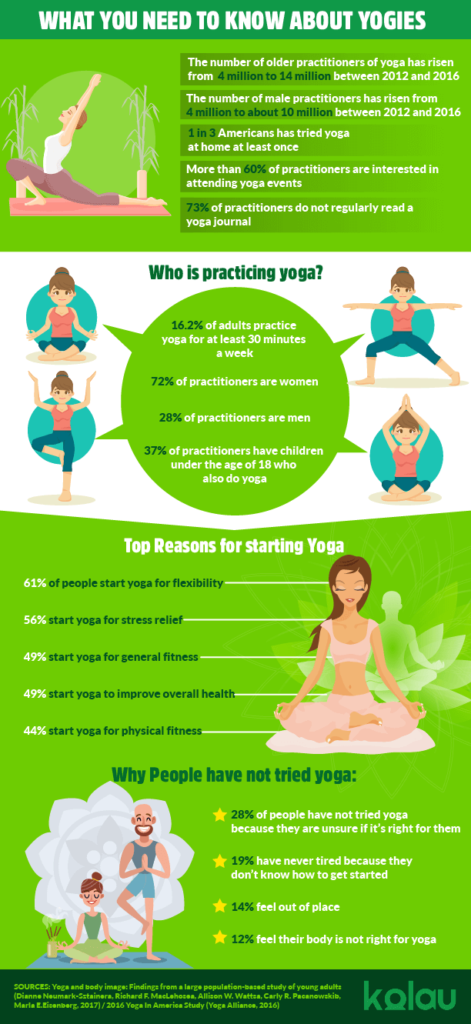
#1 Marketing Tip for Yoga Instructors: Find your Niche
The first question you need to ask yourself is: do you know your clientele? Who is in need of or enjoys your classes? This is directly connected with what kind of yoga classes you offer. Do you teach beginners’ classes or mostly advanced classes? Can your yoga help with back problems or relieve stress?
You have to understand your clientele, what they look like, and what they’re looking for in order to be able to find them using a marketing strategy. Take a look at your current classes. Are your clients older or younger? Why did they sign up? Do they have health problems or are they particularly fit? Are there many long-time students or more beginners? Do these things change depending on what class you’re teaching?
If you’re a new yoga instructor, this may be more difficult to identify. You’ll have to look at the yoga classes you offer and think of all the benefits someone could get from them. Is your yoga especially fun or spiritual? Do you teach a yoga class particularly useful for losing weight? According to a study conducted by the Yoga Alliance,
61% of people start yoga for increased flexibility, 56% start for stress relief, and 49% start to improve their health.
When marketing, it’s good to emphasize these benefits. Consider what makes you or your studio different from other yoga instructors or yoga studios. Maybe you teach classes not many other kinds of yoga studios teach. Having a niche can be very beneficial, whether the niche encompasses only one class or your whole studio.
There tends to be less competition for niche categories which can lead to good business for you. For example, you’ve probably heard of yoga studios that specialize in teaching pregnant mothers and their families. Ready Set Grow is a great example.
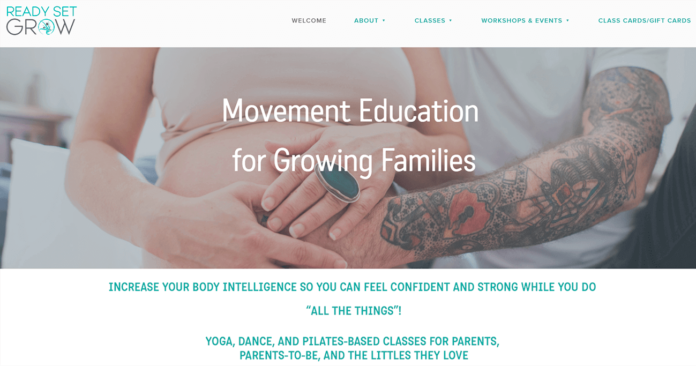
They teach prenatal yoga, postpartum yoga, and family yoga, which is a great niche category. There will always be new mothers who feel they no longer have time for yoga and there will always be pregnant women looking to stay healthy and take care of their body.
The physical restrictions of pregnancy may be difficult for yoga practitioners, so a class meant for them and their physical needs will put their minds at ease and prevent them from stopping yoga altogether during their pregnancy.
You don’t have to dedicate your whole studio to a particular group, though. Offering, for example, a class for people over fifty, a beginners’ yoga class, or a class with a focus on body positivity will bring in a group of students who may not do yoga otherwise.
The same study conducted by the Yoga Alliance found that the top reasons for people not trying yoga were: being unsure if yoga was right for them, not knowing how to get started, feeling out of place, and feeling like their body is not right for yoga. Providing a solution for these reasons will help you stand out among the crowd and fill a demand not many other people have been able or have thought to.
You could also think about providing services apart from yoga. For example, if a significant percentage of your students are parents, you could do what Yoga Union does and offer a childcare service.

It’s true Yoga Union is located in a community wellness center and so it makes sense for them to provide more services for the community around them, but if you have the means it’s worth considering filling pain points such as these that may be preventing your potential students from attending your classes.
#2 Marketing Tip for Yoga Instructors: Create Your Yoga Website
When it comes to online marketing, you should, at the very least, have a website for your business under a custom URL. Your website should at least have your business contact information, your yoga classes schedule, the cost of a class or a membership, and the location of your yoga studio.
Most yoga websites’ menus look like the one below:

There’s the homepage, which broadly introduces your visitor to your yoga business. Your homepage is a starting point, so providing easily accessible links to your registration page or showcasing special deals or incoming events is a good way to go.
Yoga Union’s homepage is very well done, starting out by introducing their visitors to a set of goals (honor, support, and connect).
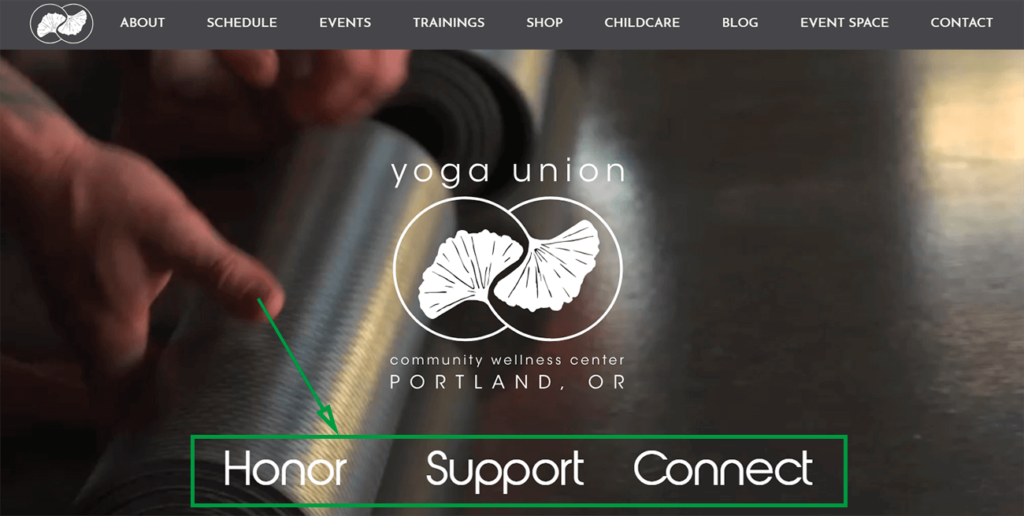
If you hover over Honor, Support, or Connect a short description of how they fulfill that goal pops up. Below that, Yoga Union showcases links to encourage visitors to become members, view the class schedule, or see what events are coming up.
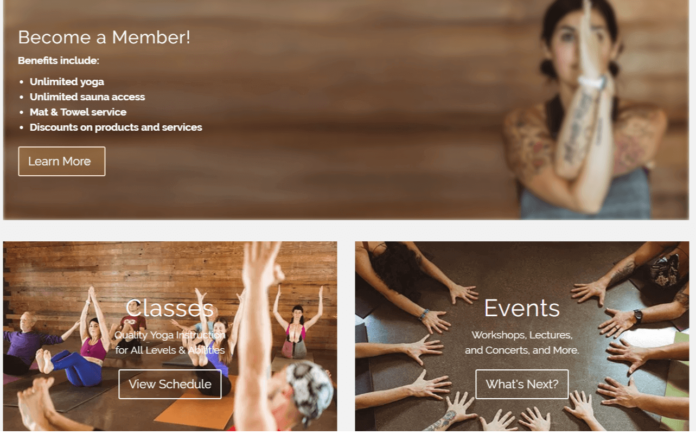
The About page is also a basic necessity for your website. The Breathing Room’s “About” consists of a map to their location, an “Info to Know” section, and a section with their contact information. They also have links, accessible through the menu, directing visitors to descriptions of their teachers and information for new students.
Yoga Union, on the other hand, uses the “About” section to answer frequently asked questions and to link to a photo gallery and to testimonials. It’s a good place to put the information you think is important for your potential or current students to know.
The “Offerings” section on The Breathing Room’s menu is used as a link to classes and the class schedule. It’s reasonable to put prices and membership benefits under the same section, though The Breathing Room has it in its own category (which is also fine). The important thing is to make it easy to find your pricing and membership information.
Lastly, the contact page is necessary but pretty simple and straightforward. That’s where you put the location of your studio (even if you also have it in your “About” page), a phone number a visitor could reach your business at, and typically an easy way to send you a message or email.
Those are the basics, but if you do anything else like write a blog or organize events or offer yoga teacher training, your website is definitely a great place to include that information. If you’re proud of your space, showcase photos of what it looks like. After all, the environment in which you teach your yoga can be important for a lot of people.
If you have a newsletter, encourage your visitors to sign up. If you’ve created videos, show them off! You may think newsletters, blogs, and videos don’t benefit you and take up too much energy but content marketing has been repeatedly proven to be very effective.
#3 Marketing Tip for Yoga Instructors: Using Content Marketing
Content marketing is all about ongoing quality. It’s not the kind of marketing strategy that will get you results instantaneously and it doesn’t work if you don’t put in genuine effort. Hubspot found that companies who published more than sixteen blog posts per month got about 3.5 times as much traffic than companies who published less than four.
This goes to show that content marketing is effective but it’s especially effective when done consistently and frequently.
You can utilize content marketing for your yoga business in a multitude of ways. You can write e-books or blogs or make videos or podcasts about yoga, teaching others what you know or sharing your journey. These are all great ways of extending your reach while helping people learn something or engage with you.
You can also put out content that is somewhat related to yoga but not necessarily about yoga. For example, you could keep a travel blog, make lifestyle videos, share health tips or healthy food recipes. Anything a yoga practitioner might be interested in or find useful is something to consider making content about.
Barre3, a workout company with multiple studios throughout the US, for example, has their own online magazine that posts articles about things from slow cooker recipes to interviews.
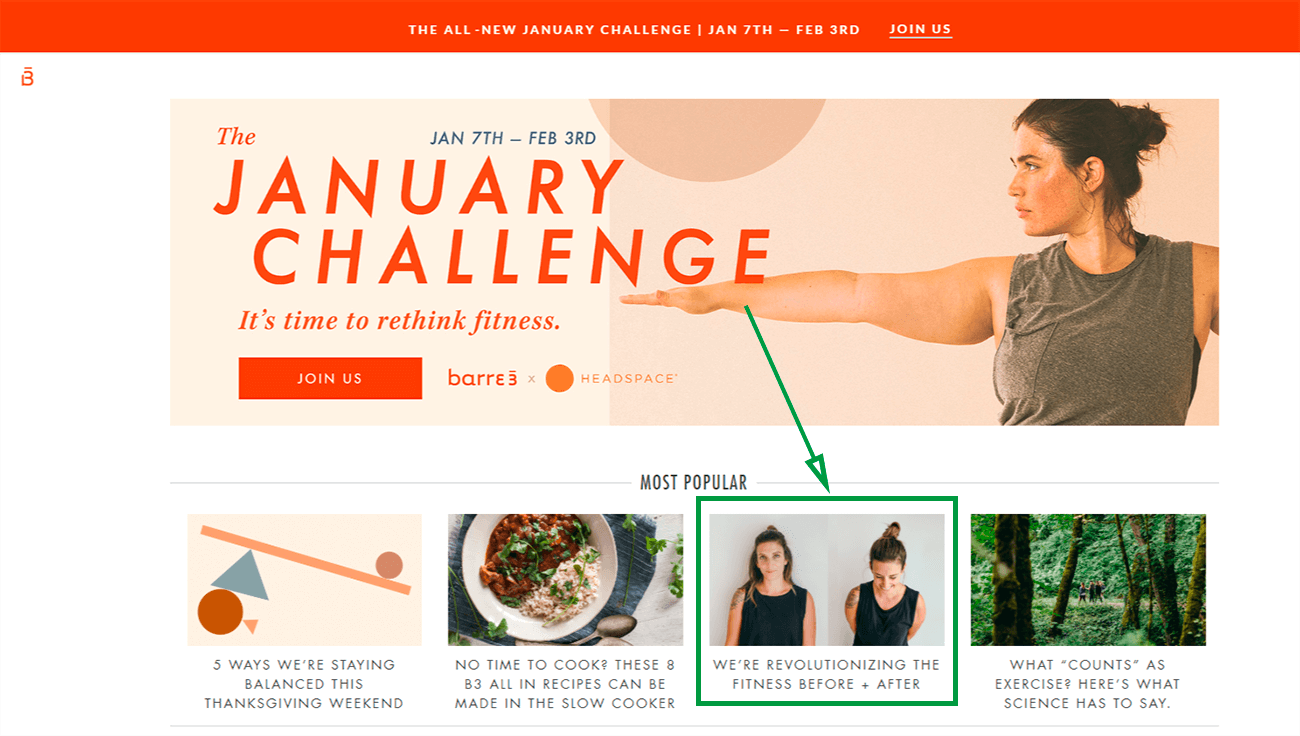
Their message of empowerment is also reflected in their articles. For example, their article titled “We’re Revolutionizing The Fitness Before + After” is explicitly about denying the “unrealistic, unattainable… unhealthy before and after photos” and making the after photo a happy ending (instead of a comparison of weight). This particular post also includes a call to action, prompting their readers to take their version of a before and after photo on Instagram.
Call-to-actions, especially ones that encourage participation from your visitors that feels normal and natural, are a great way to keep your visitors engaged. Referring them to social media encourages long-term engagement as well.
#4 Marketing Tip for Yoga Instructors: Try Email marketing
Email marketing can be a huge opportunity for your yoga business. Yoga is so often about creating and nurturing a community. Sending consistent, authentic, relevant emails can help with that. Not to mention, emails can help remind your students about upcoming events like retreats or special yoga classes. It’s often about keeping your current students in the loop about what’s going on with your business.
Sending out emails is a great way of connecting with newer customers and keeping current students interested in your business. Don’t spam your email list though! Keep a schedule. Decide if you want to send out emails biweekly, weekly, or monthly. Be aware that if you send too many emails, they might get marked as spam, your recipients might give up trying to keep up with them, or they might unsubscribe.
Make sure to customize your emails according to your target group too. Don’t just send the same email to everyone. See where they are in their relationship with your business.
- If they’ve signed up but have yet to attend a class, send them an email reminding them to give it a try.
- If they’ve just gone to their first class, send them an email congratulating them and suggesting more classes.
- If they’re a longtime student, send them emails about class, teacher, or schedule changes.
Customize further by sending out birthday offers. Wishing your students happy birthday creates a positive association with your business and strengthens your connection with your customer. Emails about special events or deals are good ideas as well. All your emails should contain something of value for the person who is receiving them.
Remember when creating emails to make them functional on mobile devices. Many people read their email on their phones. Also, follow all the rules for the CAN-SPAM Act, which includes making sure you offer recipients the option to unsubscribe and identifying email ads as ads. For more about email marketing, check out our article on how to tailor your email marketing campaign to each customer.
#5 Marketing Tip for Yoga Instructors: Make Yourself Seen on Social Media
Social media is all about engagement and has been found to work wonders for yoga businesses, particularly on platforms like YouTube and Instagram. Yoga jumped in popularity between 2012 and 2016, according to the Yoga Alliance, going from 20.4 million practitioners to more than 36 million. The same study found that:
65% of practitioners practice yoga at home and 50% of practitioners cited cost as the most important studio trait.
It makes sense many of these people would choose to practice at home through videos or apps and it also makes sense to meet those people where they are.
When it comes to social media marketing, posting online consistently is key. It doesn’t always need to be original content. Sharing articles you enjoyed or propping up other yoga instructors is an option as well.
YouTube
YouTube is the most popular social media site in the United States. According to a 2018 survey conducted by the Pew Research Center, 73% of Americans use YouTube. There are countless yoga YouTube videos out there. YouTube is a popular website for sharing classes with an online community. They can be however long you want, ranging from ten minutes to an hour.
This is a great way of finding beginners or people who can’t afford to go to in-person classes. Many yoga teachers also use free online classes as a way to build their online following. Often, they offer longer online classes for a fee on a separate website, usually through their own yoga website.
A great example of a yoga instructor who successfully utilized YouTube and created a huge online community is Adriene Mishler. She has four million subscribers on YouTube.
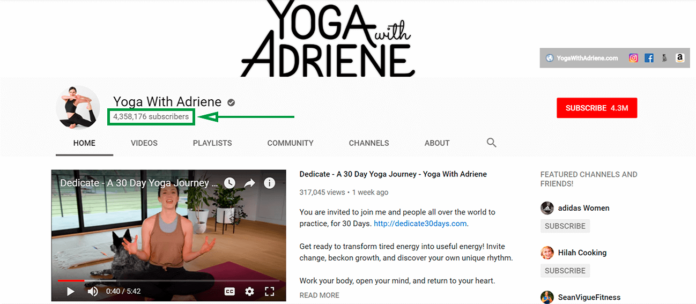
Adriene Mishler has been posting videos on YouTube for six years, uploading several times a month (sometimes a week) and accumulating more than 345 million views. Her success is rare, but it also shows what you can achieve with great marketing and dedication.
Her consistency–posting videos frequently for six years–and the accessibility of her videos definitely play a part in her popularity. She sets challenges, such as her 30-day challenge titled “Dedicate,” that are doable both for beginner yoga practitioners and more advanced ones.
If YouTube class videos is a direction you choose to go, it would be a good idea to post a decent number of classes that are accessible for beginners.
There are other types of YouTube videos you can post that would also be beneficial. You can post informational videos. Your videos could explain the benefits of yoga or define Vinyasa or share what you know of the history, for example. Making videos, in this case, is both social media and content marketing.
Instagram is a popular place for yoga. You’ve probably seen (or even posted) photos of fit yogis in difficult poses. These kinds of pictures are expected from a yoga account and you should absolutely post them on your Instagram. Though, it wouldn’t hurt to add some variety to what you post. This is true for nearly all social media platforms, not just Instagram.
First, decide if you want to market yourself or your studio on Instagram. If you’re marketing yourself, your account will have to focus a bit more on your personality and most pictures will likely include you or someone your followers might recognize. Take a look at Rachel Brathen’s page. She identifies as a “Yoga Girl” and a mom in her Instagram bio.

Her photos reflect what she’s told us in her bio. We see her meditating on the beach (some of her other photos also show her practicing yoga more clearly). We see her with her children and with her romantic partner. Her Instagram appears personal. She has a good mix of photos that appear to be taken herself (such as photos of her kids and selfies) and photos that appear professionally taken with gorgeous backgrounds such as the one below.
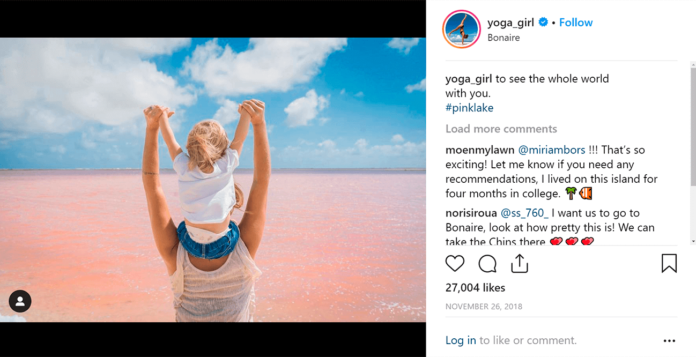
The real marketing comes in, casually, in her bio, where she writes, “JOIN OUR YOGA RETREATS + TEACHER TRAININGS!” She includes a URL that will take those interested to the yogagirl.com website.
Rachel Brathen also has a YouTube channel, which she uses to post the occasional yoga videos but, unlike Adriene Mishler, also has many videos about her and her family in the style of lifestyle YouTubers.
If you choose to market your studio instead of yourself as a yoga teacher, you can go about it a different way. You can still post photos of you or your fellow yoga teachers (or students) in impressive yoga poses. You can also showcase events happening at your studio or show off what the studio itself looks like. You can post pictures of classes, such as the one below by the yoga studio, Parallel 45.
Of course, you could do the same with an individual account. The main difference is that an account for a studio will inherently be more focused on community, not just one person.
When it comes to social media marketing, you can’t forget Facebook. It’s the second most popular social media platform in the United States, losing only to YouTube. According to the same Pew Research Center survey mentioned earlier, 68% of Americans use Facebook.
At the bare minimum, you should create a business page for you or your studio–somewhere people searching can find information. Your Facebook business page can be a great place to bring in new students curious about your business and keep current or long-time students updated on events and classes.
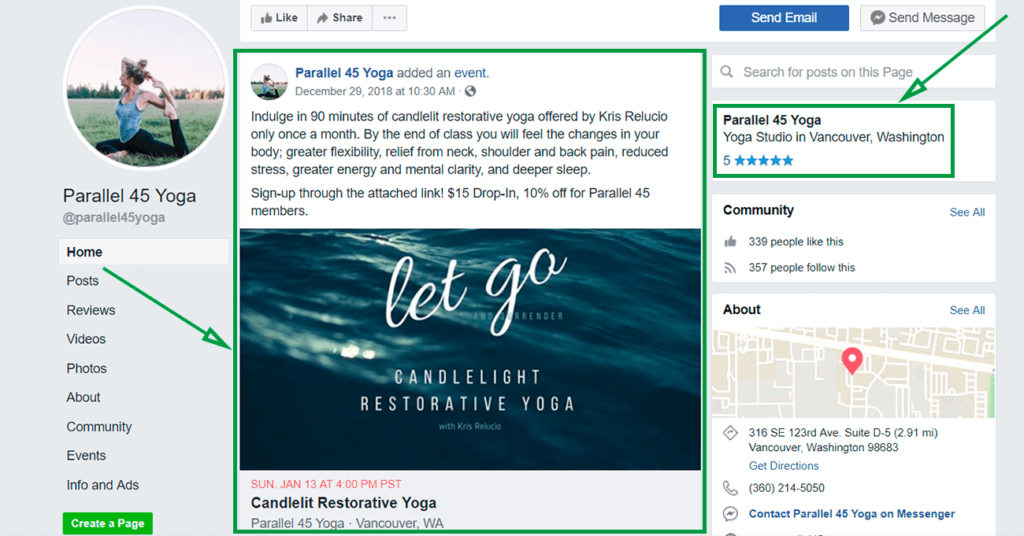
Parallel 45’s Facebook page does a good job in many ways. They advertise a special event (CandleLight Restorative Yoga), making it easy for people who come across the post to RSVP or save the event on Facebook. Facebook also lets the user’s friends know they are interested in the event, spreading awareness.
Next, they have their 5-star rating showcased on the right side. If you’ve gotten positive reviews on Facebook, show them! They increase trust in your business. The Spiegel Research Center found that displaying reviews can increase conversion rates by 270%. Same with the “Community” section. Parallel 45 has a decent amount of likes and follows, showing that it’s not just a few people that think they’re great.
More tips on Social Media Marketing
Apart from making you seen by potential and current students, social media has the benefit of helping you keep in contact with other yoga instructors or even to connect with instructors you hadn’t known previously. You can prop up other instructors through your posts or give them credit when they give you an idea for something. Chances are some will do the same for you and you might even end up co-teaching or hosting an event together one day.
Here’s something to keep in mind: social media is only one part of a successful marketing strategy. When talking about Adriene Mishler’s success, it’s important to note that though most of her content makes its home on YouTube, she also shares on Twitter, Facebook, and Instagram.
Not to mention, she also participates in and shares events, has her own website, runs a blog, and sends out a weekly e-letter. Rachel Brathen also does some content marketing, including participating in a podcast and creating yoga practice videos.
Another thing to keep in mind: try to keep things real. People can tell when you buy a stock photo and post it to your Instagram instead of taking a real photo of real people. Also, posting consistently is important but try to engage your followers or subscribers as well. Respond to their comments and like the Facebook posts they mention you in. Retweet and share their stories about how you helped them find a home in yoga.
#6 Marketing Tip for Yoga Instructors: Use Google Ads
Using Google ads can be a great way to grow your business but if you’re lost about how to go about getting started or making your ads effective, you’re not the only one. There can be quite a bit that goes into creating and using Google Ads. We’ll only go through the basics, but if you’re interested in learning more check out some of our other articles about Google Ads.
You’ve likely noticed the paid results that appear when you search something on Google. Google (partly) decides which ads appear on the first page using an auction, in which you set how much you’re willing to pay for keywords. However, Google also takes into account the quality of your ad, user experience, click-through rate and a variety of other things, all of which add up to your quality store.
The combination of your bid and quality score determines how much you’ll pay each time someone clicks on your ad.
Focusing on a location–for example, San Francisco if you are based there–reduces how many clicks you’ll get from users who wouldn’t actually be interested in attending your classes. If someone searches for yoga studios in New York but you’re based in San Francisco, you don’t want your ad appearing to them.
You should also pay attention to how your keywords are doing. Keywords are the words your potential students would use in a Google search to find your business. For example, someone might type “private yoga lessons.” If you offer private lessons, then you should include the phrase in your list of keywords so your ad appears when they search it.
Let’s look at some examples of yoga ads.
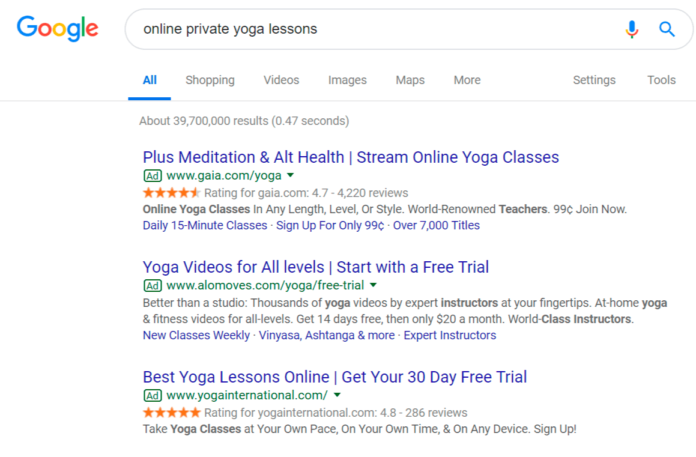
Most of these do a decent job. The first ad emphasizes meditation and health, attracting people who may be interested in that. The second ad emphasizes yoga for “All levels,” attracting people who might be beginners. They both showcase what makes them stand out.
Second, most of these show off an offer. For example, the first one offers a sign-up fee of 99 cents, which is a great deal. Alternatively, the next two offer free trials, which is also appealing.
Third, two of them show their positive ratings as well. As mentioned earlier, positive ratings increase trust in your business. Gaia.com has over 4,220 reviews, making it that much more reliable. It makes sense they would be the first to appear.
Google also offers another kind of ads: display ads. You see Display ads when you’re browsing a website and a banner or a video ad relevant to your interests appears on the top or side of the page. Sometimes, it’s an ad from a website you had clicked on earlier. They look like this:
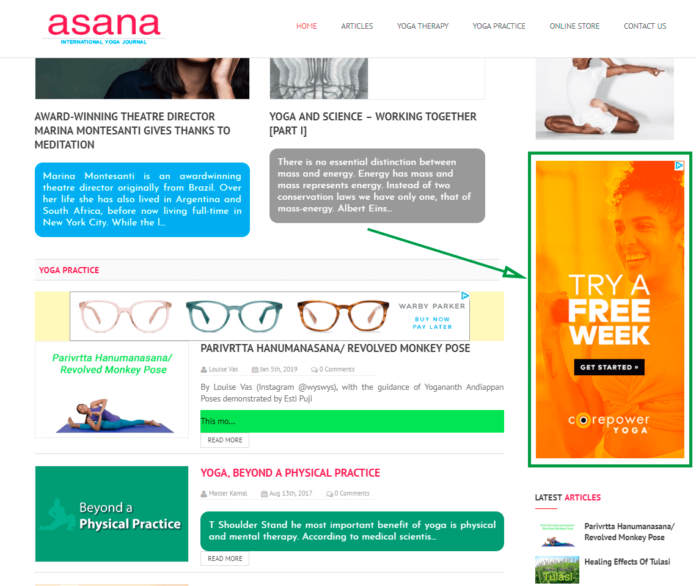
You can use these kinds of ads to target people who browse through yoga websites and may be interested in classes or to people who visited your site and left without taking action (known as retargeting or remarketing).
#7 Marketing Tip for Yoga Instructors: Use Offline Marketing Tactics
Yoga is often about community and so you can’t forget about your offline marketing. This is all about connecting with your fellow yogis in real life.
Advertising on Magazines
Have you ever received a free magazine in the mail? If you’ve ever flipped through one, you’ll notice that some ads contain free offers, such as coupons for a free book or a free beginner’s yoga class. For a yoga business, connecting with and bringing in the community around it is important and paying to advertise yourself in a local magazine can help you bring more members of your community into your classes.
Print ads are the most trustworthy form of ads, according to MarketingSherpa. While only 61% of people trust search engine ads (the highest trust rate for all online ads), 82% trust print ads.
It’s not enough to just make yourself known, though. Like with many other marketing tactics, you should focus on something you can give your potential student. What is the benefit for them? You can use the whole ad to highlight the great things about your yoga practice, studio, or qualifications, but it won’t work as well as giving the reader something they want.
So, if you’re holding a free class, advertise it in magazines popular with your community or ones they receive without having to pay or opt-in for. Or use coupons as a one-time cost waiver, so that whoever uses it can take a specific class for free. If the coupon is for a recurring class, it’s best to put an expiration date or to keep the coupon (rather than handing it back) after its been used to prevent abuse of the offer.
You don’t have to limit yourself only to free yoga classes. Give away free yoga products if someone shows up to one of your classes or give away entry to a special event. Whatever it may be you’re giving away for free, make sure you know the audience you’re advertising to.
When picking a magazine, investigate their audience and if it overlaps with your marketing targets. Fitness, women, and community-based magazines may contain the demographic you’re looking for, especially if they occasionally (or often) write about yoga or local businesses, but chances are magazines about cars or birds won’t work as well for you.
Generally, you should be honest about what you’re offering. Don’t try to hide it if your offer includes fees, such as shipping and handling. If, for some reason, signing up for your offer will incur other fees, make it as clear as you can. For example, if someone comes to your studio and discovers what they thought was a free class is going to charge them to rent a yoga mat or that the coupon only covered 60 minutes of a 90-minute class, they may not be happy with you.
The same is true if you require them to do anything other than show up–for example, if the coupon is only valid if they sign up online or through the phone first, you should request they do so in the magazine ad. Any conditions should be made clear. You don’t want to trick them into paying for something. You want to gain their trust and make them pleased enough they’ll return to your studio.
Word of Mouth (Referral Marketing)
You can’t underestimate the power of word of mouth. The Yoga Alliance notes that 65% of yoga studio owners take into account their friends and professional acquaintances’ referrals when hiring new teachers. 40% of people get their yoga information from their friends and 33% of people take up yoga because of their friends.
Often, “referral marketing” happens naturally. You just have to provide the best service you can and engage meaningfully with your students. If you’re good at what you do, you’ll be recommended to others.
Though, you don’t have to just hope you’re students will recommend you to their friends without saying anything. Encouraging students after a class to tell a friend about their experience or about an upcoming event or special class is something to consider. If someone compliments you or your yoga practice, suggest they tell their friends about it too.
You could also offer incentives. For example, if someone convinces a friend to sign up for a month, you give that person free classes or a gift card.
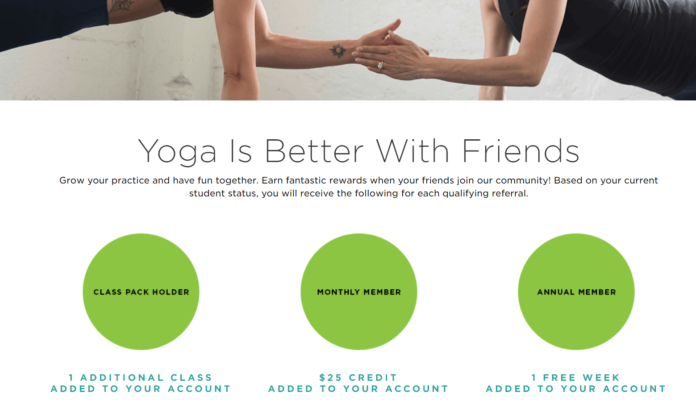
This is a good example. The longer the referral lasts, the better the incentive, but also take a look at the headline. “Yoga Is Better With Friends” encourages the visitors of this page to refer friends for their own benefit and happiness. “Wouldn’t yoga be more fun with your best friend?” it asks.
Keep good relationships with other instructors
Networking and maintaining positive relationships with other instructors will help you in the long run. As mentioned earlier, when hiring, many owners take into account what other instructors say. Not to mention, connections will bring more opportunities such as co-teaching and substituting. Just remember to return the favor!
Keep the cycle of giving and receiving going. If you’re just starting out as a yoga instructor, the connections you build will help you get going and find students outside of the online world.
Volunteer at community centers and occasionally give free classes
According to the Yoga Alliance, the third most common way practitioners began yoga is through a free class. Advertise it well online and around your neighborhood (such as local magazines, as mentioned) and you’ll bring in plenty of beginner students or even students looking for a new studio.
Volunteering at a community center or giving a donation class will expose you to more people, especially people trying out yoga for the first. You’ll have the opportunity to connect with more professional acquaintances as well. Not to mention, you’ll be doing something good for your community!
Hold special events
Like Parallel 45’s CandleLight Restorative Yoga event, special events will create a stronger community within your studio, attract new people, or even bring back people who may have temporarily stopped practicing.
Fun, community-oriented events such as bingo where the winner gets a limited amount of free classes–something else Parallel 45 has done as a New Year’s Event–are great ways to encourage current students to continue attending and grab the interest of potential students.
Hopefully, you found these marketing tips for yoga instructors helpful! If you did and you’re interested in any more social media strategies, we’ve written an article about social media strategies for small businesses. Check it out!


















